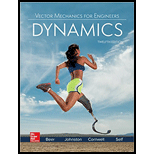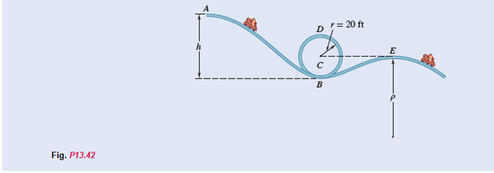
Concept explainers
A roller coaster starts from rest at A, rolls down the track to B, describes a circular loop of 40-ft diameter, and moves up and down past point E. Knowing that

(a)
Estimate the force exerted by the seat on the rider by using given information.
Answer to Problem 13.42P
The value of force at point B is NB=1120Ib and at point D is ND=160Ib.
Explanation of Solution
Given information:
Diameter=40ft
Height=60ft
The force exerted by the seat on the rider at point B and D.
Consider the free body diagram we get,
Mass of the rider is
Acceleration due to gravity is
Resultant acceleration acting on the rider at the point B is
Normal force exerted on the rider by the seat at the point B is
Resolve the forces acting on the rider by Newton’s second law.
Apply the principle of work and energy to the roller coaster at point A and point B.
Acceleration acting on the rider at the point B
Work done by the rider in reaching position B from position A is
The rider is at rest at position A is,
Then the kinetic energy of the rider at point B is,
Then the work done by the rider in reaching position B from position A,
Substitute above values we get,
Resultant acceleration acting on the rider at point B travelling in a circular track with radius of the curvature is r.
Substituting required values in the above equation we get,
Substitute
Now we get,
Forces acting on the riders by Newton’s second law
Apply the principle of work and energy to roller coaster at point A and point D. To determine the resultant acceleration acting on the rider at the point B is,
Work done by the rider in reaching position D from position A is
The rider is at rest at position A is,
Kinetic energy of the rider at point D is,
Work done by the rider in reaching position D from position A is
Substituting required values in equation 4 we get,
Express the resultant acceleration acting on the rider at point D travelling in a circular track with radius of curvature r.
Substitute h and r values we get,
Substitute required values we get,
Then,
(b)
The minimum value of radius of curvature by using given information.
Answer to Problem 13.42P
The value of radius of curvature at point E is=80ft determined below.
Explanation of Solution

Resolve the forces acting on the rider by Newton’s second law.
Roller coaster not to leave the tract at point E we get,
Apply the principle of work and energy to roller coaster at point A and point E.
Find the resultant acceleration acting on the coaster at the point E is,
The rider is at rest at position A.
Kinetic energy of the coaster at point E is,
Equating these two we get,
Substitute required values in above equation we get,
Resultant acceleration acting on the coaster at point E travelling in a circular track with radius of curvature is
Substitute above values we get,
Want to see more full solutions like this?
Chapter 13 Solutions
VECTOR MECH...,DYNAMICS(LOOSE)-W/ACCESS
- (read image) (answer given)arrow_forward11-5. Compute all the dimensional changes for the steel bar when subjected to the loads shown. The proportional limit of the steel is 230 MPa. 265 kN 100 mm 600 kN 25 mm thickness X Z 600 kN 450 mm E=207×103 MPa; μ= 0.25 265 kNarrow_forwardT₁ F Rd = 0.2 m md = 2 kg T₂ Tz1 Rc = 0.4 m mc = 5 kg m = 3 kgarrow_forward
- 2. Find a basis of solutions by the Frobenius method. Try to identify the series as expansions of known functions. (x + 2)²y" + (x + 2)y' - y = 0 ; Hint: Let: z = x+2arrow_forward1. Find a power series solution in powers of x. y" - y' + x²y = 0arrow_forward3. Find a basis of solutions by the Frobenius method. Try to identify the series as expansions of known functions. 8x2y" +10xy' + (x 1)y = 0 -arrow_forward
- Hello I was going over the solution for this probem and I'm a bit confused on the last part. Can you please explain to me 1^4 was used for the Co of the tubular cross section? Thank you!arrow_forwardBlood (HD = 0.45 in large diameter tubes) is forced through hollow fiber tubes that are 20 µm in diameter.Equating the volumetric flowrate expressions from (1) assuming marginal zone theory and (2) using an apparentviscosity for the blood, estimate the marginal zone thickness at this diameter. The viscosity of plasma is 1.2 cParrow_forwardQ2: Find the shear load on bolt A for the connection shown in Figure 2. Dimensions are in mm Fig. 2 24 0-0 0-0 A 180kN (10 Markarrow_forward
- determine the direction and magnitude of angular velocity ω3 of link CD in the four-bar linkage using the relative velocity graphical methodarrow_forwardFour-bar linkage mechanism, AB=40mm, BC=60mm, CD=70mm, AD=80mm, =60°, w1=10rad/s. Determine the direction and magnitude of w3 using relative motion graphical method. A B 2 3 77777 477777arrow_forwardFour-bar linkage mechanism, AB=40mm, BC=60mm, CD=70mm, AD=80mm, =60°, w1=10rad/s. Determine the direction and magnitude of w3 using relative motion graphical method. A B 2 3 77777 477777arrow_forward
 Elements Of ElectromagneticsMechanical EngineeringISBN:9780190698614Author:Sadiku, Matthew N. O.Publisher:Oxford University Press
Elements Of ElectromagneticsMechanical EngineeringISBN:9780190698614Author:Sadiku, Matthew N. O.Publisher:Oxford University Press Mechanics of Materials (10th Edition)Mechanical EngineeringISBN:9780134319650Author:Russell C. HibbelerPublisher:PEARSON
Mechanics of Materials (10th Edition)Mechanical EngineeringISBN:9780134319650Author:Russell C. HibbelerPublisher:PEARSON Thermodynamics: An Engineering ApproachMechanical EngineeringISBN:9781259822674Author:Yunus A. Cengel Dr., Michael A. BolesPublisher:McGraw-Hill Education
Thermodynamics: An Engineering ApproachMechanical EngineeringISBN:9781259822674Author:Yunus A. Cengel Dr., Michael A. BolesPublisher:McGraw-Hill Education Control Systems EngineeringMechanical EngineeringISBN:9781118170519Author:Norman S. NisePublisher:WILEY
Control Systems EngineeringMechanical EngineeringISBN:9781118170519Author:Norman S. NisePublisher:WILEY Mechanics of Materials (MindTap Course List)Mechanical EngineeringISBN:9781337093347Author:Barry J. Goodno, James M. GerePublisher:Cengage Learning
Mechanics of Materials (MindTap Course List)Mechanical EngineeringISBN:9781337093347Author:Barry J. Goodno, James M. GerePublisher:Cengage Learning Engineering Mechanics: StaticsMechanical EngineeringISBN:9781118807330Author:James L. Meriam, L. G. Kraige, J. N. BoltonPublisher:WILEY
Engineering Mechanics: StaticsMechanical EngineeringISBN:9781118807330Author:James L. Meriam, L. G. Kraige, J. N. BoltonPublisher:WILEY





